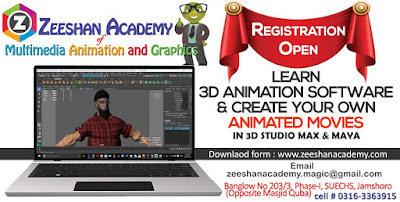Maya Video Training ::.. Lesson 2_GUI Basics (Language Urdu)
Maya’s interface hasn’t changed much since its conception, probably because the development team at Alias created a functional and easy-to-grasp user interface from the start. In this lecture, we explore the Maya interface by first learning the placement of the most use full buttons and windows and then by using them in a simple step-by-step tutorial.
The Title Bar
The title bar displays the Maya version number, the name of the scene you are working on, and the name of any object you have selected. It also includes standard Minimize and Maximize buttons and a Close button.The Menu Bar
The menu bar lets you quickly access numerous functions in Maya via pull-down menus. The contents of each pull-down menu give you access to related tools, commands, and settings, and, when available, the menu lists the keyboard shortcuts for executing tools or commands.Menu Sets
Because Maya has so many menus, they won’t all fit in a single-row menu bar. The Maya interface solves this space problem by partitioning menus in menu sets. A menu set is divided up based on tools and commands related to a particular workflow.There are five menu sets available in Maya Complete: Animation, Polygons, Surfaces, Dynamics, and Rendering. Maya Unlimited has one additional menu set for Cloth. You can access these menu sets from the menu selector’s drop-down list on the status line, as shown in the illustration. After you have selected a menu set, you will notice that some of the options in the menu bar will change according to the set you chose.
You can also access these menu sets by pressing keyboard commands, or hot keys, as shown below.
You can also choose a menu set by pressing the H key while you hold down the left mouse button in the view window. A marking menu will appear, containing each menu set, as shown in
HOT KEY MENU SET
F2 Animation
F3 Polygons
F4 Surfaces
F5 Dynamics
F6 Rendering
The Status Line
The status line includes valuable tools you can use while you are working, such as selection masks, snapping modes, and a rendering button. We will exploresome of these tools and buttons in the tutorial later in this chapter. We’ll use
others throughout the book. Figure 2-4 shows arrangements of useful buttons on the status line.
The Video Lecture
In this Lecture we learn the basic User Interface of Maya in Urdu Language.




